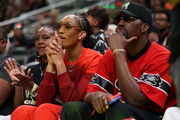
Imago
Image credits : Imago

Imago
Image credits : Imago
In the shiny world of professional sports, where players display unmatched commitment and talent, a deeper examination of the financial scene reveals a notable discrepancy between on-field victories and salary. A recent study encompasses specialized sports to comprehend why well-known athletes, despite their achievements, have monetary issues.
Watch What’s Trending Now!
Further, it raises issues of equity and fairness in athlete compensation and demands a critical analysis of the economic systems that underpin the sports industry. The pay discrepancy prevalent in the gymnastic world was recently shone a light on, a matter that needs redressal if the sport needs to thrive.
ADVERTISEMENT
Simone Biles’ contrasting compensation
A recent tweet by @thorpeheath ignited a conversation that went beyond the typical appreciation for athletes, a poignant question regarding the financial realities faced by some of the world’s most accomplished female athletes, such as Simone Biles and Mikaela Shiffrin, was raised by the tweet that featured a picture of them. “It is wild to me that you can be as successful as Simone Biles in gymnastics and earn essentially ZERO dollars from prize money,” the caption said. This cash crunch issue is deep-rooted across the board, as is evident. The skewed results also display a stark contrast vis-à-vis actual remuneration and brand deals.
It is wild to me that you can be as successful as Simone Biles in gymnastics and earn essentially ZERO dollars from prize money. She is rightfully making money from endorsements but it goes to show how reliant gymnasts are on their sponsorships
Source: https://t.co/OuZbNyn6PG pic.twitter.com/oxD6wlohp1
— Heath Thorpe (@thorpeheath) December 20, 2023
The tweet further added, “She is rightfully making money from endorsements, but it goes to show how reliant gymnasts are on their sponsorships.” Skiing sensation Mikaela Shiffrin and other extraordinary athletes like Coco Gauff and Iga Świątek faced a similar conundrum: they produced amazing results on the field or slope, but their careers relied heavily on sponsorships to continue. The abysmal pay gaps with Biles netting $0 in prize money is a heartbreaking reality.
ADVERTISEMENT
The figures were striking: the four-time gold medalist at the Olympics, Biles, took home $8.5 million, but her prize money made up barely any of that total. Though Shiffrin fared slightly better with $6.1 million from her multiple World Cup victories, her main source of income came from social media endorsements. Yul Moldauer, a men’s artistic gymnast who has won multiple competitions, is a prime example of the financial disparity that athletes in less popular sports face.
Top Stories
Andy Reid Announces Patrick Mahomes’ Injury Diagnosis as Chiefs HC Doesn’t Hold Back After Playoffs Elimination

Former US President Joe Biden Keeps a Clear Demand to Eagles Owner Amid Jalen Hurts’ Struggles

Cowboys Star Risks Severe Punishment Over Justin Jefferson Incident vs Vikings

A’ja Wilson, Bam Adebayo Issue Strong Statement Against Rachel Nichols’ Question About Couple’s Privacy

NFL Announces Punishment for Shedeur Sanders Incident

Diego Pavia Issues Public Statement After Heisman Controversy Triggers Strong Reaction

ADVERTISEMENT
Overlooking the men’s sanctions
Yul’s reported net worth as of 2022 is $1.7 million, which is relatively low when compared to athletes in more prominent sports, despite his accomplishments. His yearly compensation, which ranges from $70,000 to $90,000 USD, highlights the difficulties gymnasts, even the most successful ones, face in terms of money.
Moldauer’s story points out the difficulties faced by athletes in sports with less commercial visibility, even though Biles and Yul have been able to establish their reputations with their World performance. While we continue to commemorate these athletes’ victories, we must critically examine the economic systems that support their careers to make sure that their hard work, talent, and sacrifice are fairly compensated. It begets the question – is branching out the way to go?
ADVERTISEMENT
Watch this story SIMONE BILES’ BEYOND TWISTIES: THE UNTOLD STORY BEHIND HER MENTAL HEALTH ADVOCACY
ADVERTISEMENT
ADVERTISEMENT
ADVERTISEMENT

